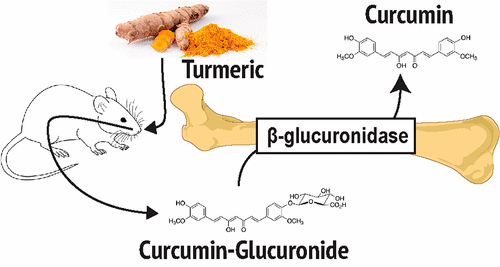当前位置:
X-MOL 学术
›
J. Nat. Prod.
›
论文详情
Our official English website, www.x-mol.net, welcomes your
feedback! (Note: you will need to create a separate account there.)
Beta-Glucuronidase Catalyzes Deconjugation and Activation of Curcumin-Glucuronide in Bone.
Journal of Natural Products ( IF 3.3 ) Pub Date : 2019-02-22 , DOI: 10.1021/acs.jnatprod.8b00873 Andrew G Kunihiro , Paula B Luis 1 , Julia A Brickey , Jen B Frye , H-H Sherry Chow , Claus Schneider 1 , Janet L Funk
Journal of Natural Products ( IF 3.3 ) Pub Date : 2019-02-22 , DOI: 10.1021/acs.jnatprod.8b00873 Andrew G Kunihiro , Paula B Luis 1 , Julia A Brickey , Jen B Frye , H-H Sherry Chow , Claus Schneider 1 , Janet L Funk
Affiliation

|
The biological basis for documented in vivo bone-protective effects of turmeric-derived curcumin is unclear since curcumin is barely detectable in serum, being rapidly conjugated to form what is thought to be an inactive glucuronide. Studies were therefore undertaken to test the postulate that antiresorptive effects of curcumin require deconjugation within bone to form the bioactive aglycone and that β-glucuronidase (GUSB), a deconjugating enzyme expressed by hematopoietic marrow cells, facilitates this site-specific transformation. Consistent with this postulate, aglycone, but not glucuronidated, curcumin inhibited RANKL-stimulated osteoclastogenesis, a key curcumin target in bone. Aglycone curcumin, expressed relative to total curcumin, was higher in bone marrow than in serum of curcumin-treated C57BL/6J mice, while remaining a minor component. Ex vivo, under conditions preventing further metabolism of the unstable aglycone, the majority of curcumin-glucuronide delivered to marrow in vivo was hydrolyzed to the aglycone, a process that was inhibited by treatment with saccharolactone, a GUSB inhibitor, or in mice having reduced (C3H/HeJ) or absent (mps/mps) GUSB activity. These findings suggest that curcumin, despite low systemic bioavailability, may be enzymatically activated (deconjugated) within GUSB-enriched bone to exert protective effects, a metabolic process that could also contribute to bone-protective effects of other highly glucuronidated dietary polyphenols.
中文翻译:

β-葡萄糖醛酸酶催化骨中姜黄素-葡萄糖苷酸的解结合和活化。
姜黄来源的姜黄素体内骨骼保护作用的生物学基础尚不清楚,因为姜黄素在血清中几乎检测不到,并迅速结合形成被认为是无活性的葡萄糖醛酸苷。因此,进行了研究来测试姜黄素的抗吸收作用需要在骨内解结合以形成生物活性糖苷配基,并且β-葡萄糖醛酸酶(GUSB)(一种由造血骨髓细胞表达的解结合酶)促进这种位点特异性转化。与这一假设一致,姜黄素糖苷配基而非葡萄糖醛酸化的姜黄素抑制 RANKL 刺激的破骨细胞生成,破骨细胞生成是骨中姜黄素的关键靶标。相对于总姜黄素的糖苷配基姜黄素在骨髓中的表达量高于姜黄素治疗的 C57BL/6J 小鼠的血清中,但仍然是次要成分。体外,在防止不稳定糖苷配基进一步代谢的条件下,体内输送到骨髓的大部分姜黄素-葡萄糖醛酸苷被水解为糖苷配基,这一过程通过用糖内酯(一种 GUSB 抑制剂)处理或在小鼠中减少( C3H/HeJ) 或缺失 (mps/mps) GUSB 活动。这些发现表明,尽管姜黄素的全身生物利用度较低,但它可能在富含 GUSB 的骨骼中被酶促激活(解结合)以发挥保护作用,这一代谢过程也可能有助于其他高度葡萄糖醛酸化的膳食多酚的骨骼保护作用。
更新日期:2019-02-22
中文翻译:

β-葡萄糖醛酸酶催化骨中姜黄素-葡萄糖苷酸的解结合和活化。
姜黄来源的姜黄素体内骨骼保护作用的生物学基础尚不清楚,因为姜黄素在血清中几乎检测不到,并迅速结合形成被认为是无活性的葡萄糖醛酸苷。因此,进行了研究来测试姜黄素的抗吸收作用需要在骨内解结合以形成生物活性糖苷配基,并且β-葡萄糖醛酸酶(GUSB)(一种由造血骨髓细胞表达的解结合酶)促进这种位点特异性转化。与这一假设一致,姜黄素糖苷配基而非葡萄糖醛酸化的姜黄素抑制 RANKL 刺激的破骨细胞生成,破骨细胞生成是骨中姜黄素的关键靶标。相对于总姜黄素的糖苷配基姜黄素在骨髓中的表达量高于姜黄素治疗的 C57BL/6J 小鼠的血清中,但仍然是次要成分。体外,在防止不稳定糖苷配基进一步代谢的条件下,体内输送到骨髓的大部分姜黄素-葡萄糖醛酸苷被水解为糖苷配基,这一过程通过用糖内酯(一种 GUSB 抑制剂)处理或在小鼠中减少( C3H/HeJ) 或缺失 (mps/mps) GUSB 活动。这些发现表明,尽管姜黄素的全身生物利用度较低,但它可能在富含 GUSB 的骨骼中被酶促激活(解结合)以发挥保护作用,这一代谢过程也可能有助于其他高度葡萄糖醛酸化的膳食多酚的骨骼保护作用。





















































 京公网安备 11010802027423号
京公网安备 11010802027423号